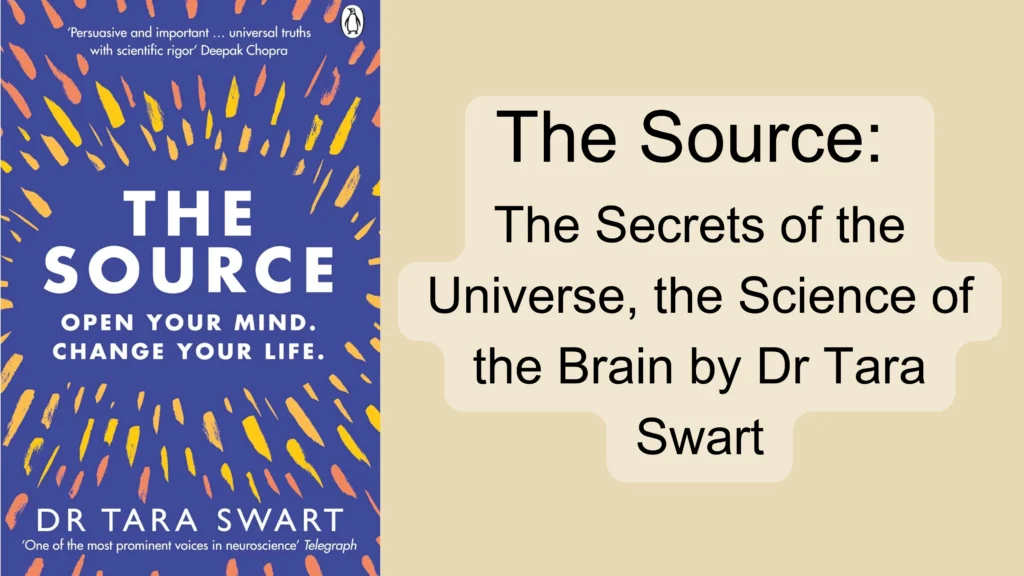The Source: The Secrets of the Universe, the Science of the Brain by Dr Tara Swart
When a neuroscientist and senior lecturer at MIT speaks about intuition, manifestation, and signs from the universe, people tend to listen. Dr. Tara Swart’s The Source marks a significant shift in modern science writing – a rigorous scientist’s journey from strict materialism to acknowledging that science has been exploring the wrong avenues for answers to some of life’s deepest questions.
Dr Swart does not arrive at her expanded worldview through mystical experience or religious conversion; she does so through careful observation of phenomena that her scientific training cannot fully explain. As a neuroscientist who once dismissed anything that could not be measured in a laboratory, she noticed patterns in human experience that challenge conventional scientific understanding: spontaneous healings, meaningful coincidences, intuitive knowing, and experiences of connection with deceased loved ones that seemed too specific and consistent to dismiss as wishful thinking or grief-induced hallucination.
What makes Swart’s perspective so valuable is her willingness to recognise the limitations of traditional scientific methodology. She writes honestly about how science, despite its immense contributions to human knowledge, has created a self-imposed blindness by refusing to examine phenomena that do not fit within its existing paradigms. Science, she suggests, has become like a person searching for lost keys only under the streetlamp—not because that’s where the keys were dropped, but because that’s where the light is.
SIGN UP TO MAILING LIST
The Science That Doesn’t Know What It Doesn’t Know
Swart’s central critique of contemporary science is both daring and essential: science has become ensnared in what she terms “explanatory adequacy”—the belief that if we can develop a materialist explanation for something (regardless of how convoluted or improbable), we should favour it over explanations that incorporate non-physical aspects of reality. This is ideology disguising itself as objectivity.
She contends that science has ceased to be genuinely curious about the full spectrum of human experience. When confronted with phenomena that challenge the materialist paradigm—such as intuition that proves accurate, signs and synchronicities that appear too meaningful to be mere coincidence, or healing that takes place through consciousness and intention—the scientific establishment fails to investigate these phenomena with true openness. Instead, it dismisses them outright as impossible or devises elaborate explanations that uphold materialist assumptions at all costs.
Swart suggests this approach is the opposite of genuine scientific investigation. True science follows evidence wherever it leads, even if it challenges core assumptions. However, contemporary science has become cautious, defending a worldview rather than exploring reality with true curiosity.
Consciousness and the Afterlife
Her discussion of consciousness is particularly compelling. Instead of viewing consciousness as a product of brain activity (the usual materialist perspective), Swart presents convincing evidence that consciousness might be primary — that the brain acts more like a receiver or focusing device for consciousness rather than its origin. This perspective aligns with ancient spiritual traditions and is also supported by quantum physics, as well as the unresolved “hard problem” of how subjective experience arises from objective matter.
Throughout The Source, Swart recounts her personal experiences with signs and synchronicities, including what she describes as communication from deceased loved ones. These weren’t vague feelings or vague symbols, but specific, detailed messages that conveyed information she couldn’t have known through normal means. Her scientific background initially prompted her to seek rational explanations, but eventually, the strength of the evidence compelled her to consider that consciousness might indeed persist after physical death—and that communication across this boundary could be possible.
She does not present this as a proven fact but as a hypothesis worthy of serious investigation—one supported by far more evidence than most scientists are willing to recognise. The problem, she suggests, is not a lack of evidence but a lack of scientific willingness to examine the evidence with genuine openness.
SIGN UP TO MAILING LIST
A New Vision of Reality
What emerges from The Source is a vision of science that is humbler, more curious, and more willing to follow evidence wherever it leads, even into territories that challenge fundamental assumptions about the nature of reality. Swart does not ask readers to abandon critical thinking—she asks them to apply it more rigorously, including to the assumption that materialism has already explained all important aspects of human experience.
Her view of the afterlife and ongoing consciousness remains tentative yet hopeful. She suggests that death might not be an end but a transformation—a change in how consciousness manifests itself. The bonds we form through love, she argues, could endure beyond physical existence. The universe might be considerably more receptive to consciousness and intention than materialist science has been prepared to consider.
Most importantly, she contends that we require a new kind of science—one capable of exploring consciousness, meaning, intention, and subjective experience with the same thoroughness currently used for physical phenomena, but without insisting that everything must ultimately be explained in material terms.
Rating: ★★★★★
Essential reading for anyone interested in the emerging dialogue between science and spirituality, and for those seeking scientific validation of experiences that transcend material explanation.
Get you copy here!

